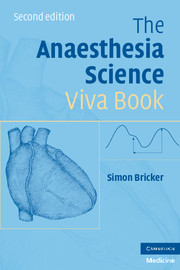Book contents
4 - Pharmacology
Summary
Chirality
Commentary
The science of chirality is somewhat indigestible, and you might feel aggrieved were this to be the only pharmacology that you were given the opportunity to discuss in the exam. The introduction of levobupivacaine and ropicaine, however, has given this subject some topical relevance and, so even if you cannot unravel the nomenclature convincingly, you will have to be prepared to talk about drugs which can be presented as pure enantiomers. (If you are struggling for facts it may help if you remember that in the case of the newer drugs, ‘R’ stands for ‘risky’ and ‘S’ stands for ‘safe’.)
The viva
The subject may be introduced by a discussion of drugs that are chiral, in particular local anaesthetics. Drugs such as bupivacaine and prilocaine are racemic mixtures which contain equal numbers of isomers or enantiomers (see below). The improved safety profile of single enantiomer preparations has given chirality more immediate anaesthetic relevance.
Bupivacaine: the S(−) enantiomer has less affinity for, and dissociates quicker from, myocardial sodium channels. The risk of cardiovascular and CNS toxicity is reduced. The S(−) enantiomer also exerts some vasoconstrictor activity.
Ropivacaine: this is the pure S(−) enantiomer of propivacaine. It also has a safer cardiovascular profile in overdose.
Prilocaine: the S(+) enantiomer is a stronger vasoconstrictor and is metabolized more slowly than the R(−) form which therefore produces higher concentrations of o-toluidine and a greater risk of methaemoglobinaemia.
Lidocaine (lignocaine): this is achiral.
You will then be asked in more detail about chirality and isomerism.
- Type
- Chapter
- Information
- The Anaesthesia Science Viva Book , pp. 193 - 282Publisher: Cambridge University PressPrint publication year: 2008

